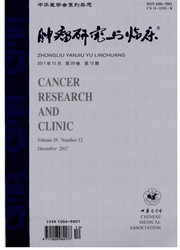

 中文摘要:
中文摘要:
目的 调查乳腺癌患者焦虑发生情况,探讨表面增强激光解吸电离飞行时间质谱(SELDI-TOF-MS,简称SELDI)技术在焦虑评估中的临床应用价值.方法 采用便利抽样法选取121例乳腺癌患者作为研究对象,入院当日应用焦虑自评量表(SAS)对其进行评估,征得患者同意后,于次日清晨抽取患者空腹静脉血,应用SELDI技术检测血清,筛选焦虑相关蛋白质指纹图谱.分析比较SELDI检测结果与SAS量表评分.结果 121例乳腺癌患者的SAS评分为(53.45±9.78)分,发生焦虑患者63例(52.07%).以质荷比15000+H- 16800+H之间5%蛋白质指纹丰度建立诊断模型,即以SELDI检测蛋白质指纹丰度值≥5%判断为阳性,反之为阴性,在此基础上准确将乳腺癌患者分为焦虑组与非焦虑组.SELDI正确率(总符合率)为91.74%,特异度和灵敏度分别为89.66%(52/58)、93.65%(59/63),阳性预测值为90.77%(59/65),阴性预测值为92.86%(52/56).结论 乳腺癌患者焦虑发生率较高.SELDI技术在焦虑情绪的评估方面表现出较高的灵敏性和特异性,作为一种客观的评估手段,具有较好的临床运用前景。
 英文摘要:
英文摘要:
Objective To investigate the incidence of anxiety in patients with breast cancer,and further explore the surface-enhanced laser desorption/ionization time-of-flight mass spectrometry (SELDI) technology' s clinical value in the diagnosis of anxiety.Methods 121 breast cancer patients were selected as research objects by using convenience sampling method.Self-rating anxiety scale (SAS) was used to evaluate the anxiety on the first day of admission and SELDI was used on the next day to detect the serum from patients' fasting venous blood sample got in the morning after their consent,then anxiety-related protein fingerprints spectrums were selected.The SAS score and SELDI result were finally compared and analyzed.Results SAS score in 121 patients was 53.45±9.78,anxiety occurred in 63 cases (52.07 %).Established the diagnostic model between 15 000+H and 16 800+H protein fingerprints abundance ≥5 %,that was to say,abundance ≥5 % was judged as positive,otherwise negative.On this basis,patients can accurately be distinguished between anxious group and non-anxious group.Correct rate (total coincidence rate) was 91.74 %,specificity and sensitivity respectively were 89.66 % (52/58) and 93.65 % (59/63),the positive predictive value was 90.77 % (59/65),and negative predictive value was 92.86 % (52/56).Conclusions Breast cancer patients have a high incidence of anxiety.SELDI technology has showed high sensitivity and specificity in anxiety detecting.As an objective assessment tool,it could have better prospects for clinical use.
 同期刊论文项目
同期刊论文项目
 同项目期刊论文
同项目期刊论文
 期刊信息
期刊信息
